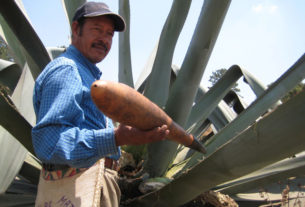“The pineapple,” wrote Fernandez de Oviedo in the 16th century, “appeals to every sense but that of hearing.” This chief steward to the royal family of Spain may seem, from a 21st century point of view, somewhat extravagant in his praise of the fruit, but history tells us that the American native Ananas comosus, a member of the bromeliad family, did indeed take Europe by storm and become a symbol of things exotic, attainable only by the wealthy and privileged.
At the time of the European conquest, pineapples grew in tropical areas of Mexico as well as the hot, humid parts of South and Central America and the Caribbean. They were widely cultivated by the Maya, who recognized them as a valuable source of nutrition and added them, along with other tropical fruits, to their corn-based diet.
The first European to eat a pineapple was Columbus, and most culinary historians agree that this took place on November 4, 1493, when he landed on the island of Guadeloupe. He described the fruit as being so delicious that a mere 20 years later it was already being exported from the New World to Europe. King Ferdinand, upon being presented the only pineapple in a 1516 shipment to Spain that made the journey without spoiling, said it was the best thing he had ever tasted. Other Europeans evidently agreed, because by the 1600s, pineapples had become a major status symbol in many parts of Europe.
One of the reasons for this was the scarcity of sweets not made with expensive cane sugar, which was then imported from the Middle East and the Orient. The other was the general unavailability of fresh fruit. The pineapple, fresh and sweet, appealed to the Europeans on both counts.
It had to be shipped green in order to make the long journey across the ocean without spoiling, but was so wildly popular among the nobility that even in the cold climate of England, specialized hothouses and soil mixtures were developed in order to propagate pineapples, which were rented out as centerpieces and incorporated into architectural and design motifs. (Later, these pineapple designs became popular in the North American colonies, where they were worked into everything from carved wooden furniture and molded mortar gateposts to ceramic bowls and gelatin molds.) Culinary anthropologist Sophie Coe wrote that “the pineapple became not just a fruit but the embodiment of everything the nobility liked to think that it stood for – wealth, hospitality, and friendship.”
By the 1800s, even after pineapples could be easily exported to most European countries and lost some of their exotic luster, they continued to be considered an extravagant luxury in more remote Russia, and pineapple in champagne was the Russian status drink until the early 20th century.
This odd-looking fruit, named for the rough exterior that resembles a pinecone and an interior as juicy as an apple, is part of the bromeliaceae family of herbs and small shrubs native to the American tropics and subtropics. The pineapple plant is a rosette of long, pointed leaves around a central bud, from which the flowering stem rises. The fruit is formed from the stem, which is surrounded by nearly 200 individual fruitlets fused together. Each “eye” on the fruit’s surface is the dried base of a small purple flower that persists even after the fruit is formed. It is the only fruit with its stem (the “core”) running through it, and contains no seeds but can be propagated by cutting off the top and planting it.
The sweet, juicy fruit contains bromelain, an enzyme that was isolated in 1891 and that works as an anti-inflammatory, giving credence to the early explorers’ observations of indigenous people using pineapple poultices to reduce inflammation in wounds. Because bromelain breaks down protein, it is a natural meat tenderizer and a digestive aid. Pineapples also contain significant amounts of vitamins A and C, manganese, and dietary fiber, and only 76 calories in a cup of cubed fruit.
Here in Mexico, pineapples are grown along the tropical coasts and in the Papaloapan river lowlands of Veracruz and Oaxaca. Loma Bonita, Oaxaca, calls itself the “Pineapple Capital of the World” because it has been, until recent times, the most important pineapple-exporting region.
Originally a colony of about 30 young North American families establishing agricultural camps in the 1890s, the Loma Bonita area and its piñales – pineapple plantations – went to the local campesinos after the foreigners were expelled from the country upon the American invasion of the port of Veracruz in 1914. During the Mexican Revolution the fields lay fallow, but cultivation began again in 1921. By the 1930s the industry had been revived, and in the 1940s refugees from Spain’s civil war had settled in Loma Bonita and started a cannery.
The United States approved the canned crushed and sliced pineapple for importation a decade later, and the canned and fresh pineapple industry thrived in Mexico, reaching its apex in the 1990s. Then, in 2000, a glut of cheap, canned Thai pineapples hit the world market and had serious consequences for Mexico’s pineapple growers, most of whom are small farmers. (The Europeans had introduced pineapples to Asia from the New World, and by 1549 the Chinese were growing them commercially.)
Although it remains to be seen whether agricultural policy and an understanding of international trade will come together for the pineapple farmers, nearly 100,000 Mexicans still depend on the pineapple industry for a living. The variety known as the Smooth Cayenne is grown in the Papaloapan region and the Creole variety on the coast. Mexico exports the largest variety of pineapple, the Sugar Loaf, which weighs up to ten pounds. Mexican fresh pineapples are usually picked at 25% maturity, when one fourth of the outer surface has turned yellow. Since all the starch is in the stem and converts to sugar as it enters the fruit, the pineapple will not get any sweeter once it is harvested, so many of the “tricks” for choosing a ripe one, such as color, “sound” and loose crown leaves, are unreliable.
There are some hints, however, that are helpful in selecting a ripe, sweet fruit: the pineapple should be fragrant at the stem end, with no sour or fermented smell; it should not have any bruises or soft spots, especially at the base; it should be heavy for its size. Once home, the pineapple can be kept at room temperature for a day or two, can be refrigerated for three to five days, and can be kept cut up in an airtight container, refrigerated, for about a week. Any more time in the refrigerator would damage the fruit because of the cold.
Mexican cuisine makes great use of the pineapple for both savory foods, such as Oaxaca’s pineapple chicken, and sweet foods like the candied fruit found at just about all Mexican fairs and the pineapple-filled sweet tamales of several different regions. It is cooked with lentils and spices to make a savory Lenten dish and fermented to make the slightly alcoholic and very refreshing drink called tepache. It is good in fruit salsas, in aguas, and great on the grill as an accompaniment to chicken, pork or fish. It can be cut into a “boat” for an elegant salad presentation, cut into chunks for fruit salad or into slices for garnishes and cakes. The following recipes reflect the variety of ways in which pineapples are used in Mexican cooking.
- Pollo en Piña: Pineapple Chicken
- Salsa de Piña: Pineapple Salsa
- Dulce de Camote y Piña: Yam-Pineapple Dessert
- Agua de Piña, Pepino y Apio: Pineapple, Cucumber and Celery Drink


